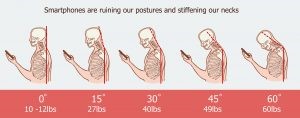Background
Headaches are extremely common, it is reported that 90% of people will experience some type of headache in their lifetime, with 50% of adults reporting at least one headache in any given year. There are many different types of headaches with differing causes, varying in severity.
With more time spent at home-made desks and looking down at smartphones and laptops, it’s important to recognise and understand the causes of your headaches, and whether it may simply be poor posture or eye strain.

With the head weighing between 10-12lb, with each degree of flexion (bringing the chin towards the chest) the load exerted on the spine and neck muscles greatly increases in order to stabilise and support the neck. As depicted above, with each increase in degree of flexion the ‘weight’/ load of the head increases dramatically, which long term may lead to chronic neck pain and headaches.
Cervicogenic Headaches (Cervico– Neck; Genic– Generating) are a common secondary headache that typically originates from the joints in the upper neck (most commonly C2/3). They are often difficult to diagnose as symptoms may be referred and can often mimic a migraine or tension-type headache.
Cervicogenic Headaches have numerous possible causes; including trauma to the neck (fracture, dislocation, or whiplash-type injury), or by medical conditions such as rheumatoid arthritis, cancer, or infection.
Symptoms of Cervicogenic Headaches:
- Headache that comes from a sudden movement of your neck
- Headache when maintaining a position for long periods
- Pain on one side of the head or face
- Headache which worsens with sneezing or coughing
- Neck stiffness
How can manual therapy help?
Before any manual therapy treatment a thorough case history and physical assessment will be carried out to exclude any underlying health issues or serious neck injury.
Manual therapy is an effective way to provide symptomatic relief from headaches, whilst in some cases it may also be successful in addressing the cause of the headaches.
The aims of manual therapy when addressing cervicogenic headaches may include:
- To improve mobility and functioning within the neck and upper back
- To maintain a balance through the cranial bones
- To release any tension/ trigger points within the neck, upper back, and cranial muscles
- To engage and strengthen the surrounding neck, upper back, and cranial muscles
Manual therapists can use a variety of techniques to achieve the above aims, from very gentle cranial techniques and soft tissue release to manipulations.
Long term your therapist will construct a plan of action with you, taking into consideration your lifestyle including activity levels, as well as considering ergonomic setup at work for example. You will most likely receive ‘homework’ from your therapist, including strengthening exercises and stretches to perform at home to prevent the reoccurrence of the issue. You may also be taught some exercises to manage and prevent stress (if this attributes towards your headaches) impacting on your musculoskeletal system.